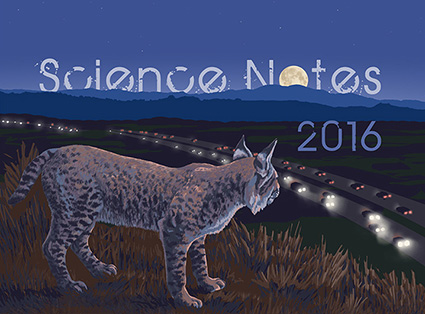The inside story of the 25-year-long quest to create the world’s first portable DNA sequencer. The misty reasons behind the diversity of California’s fragile coastal chaparral. An assessment of the latest efforts to predict earthquakes by catching unusual electrical patterns in the ground — or in the sky.
These are among the stories in Science Notes 2016, the illustrated online magazine published annually by the UC Santa Cruz Science Communication Program.
The class of 2016 ventured across the state to join teams at work. To the south, researchers revisit the same Death Valley sites charted by pioneering naturalists a century ago to gauge how climate change has affected desert ecosystems. To the west, fire scientists examine why Sierra Nevada forests have become explosively combustible — and how to lower the risks. To the north, ecologists track families of river otters to determine why the playful animals have returned to the San Francisco Bay Area after an absence of decades. And offshore, ocean scientists probe the sea’s microbiome, which controls marine life in wholly unexpected ways.
Multimedia elements enhance each story. A veteran biomolecular engineer feels he is on the verge of developing the first effective HIV vaccine, using an approach detailed in a podcast and an explanatory graphic. Wildlife biologists share images from motion-activated cameras that reveal where and how animals get past highways crossing a vital open space. And a famous lab at UCSF explores the tangled origins of a rare neurodegenerative disease — a story featuring a forthright interview with a longterm survivor.
Several of the stories focus on work by researchers at UC Santa Cruz, including biomolecular engineers David Deamer and Mark Akeson (nanopore sequencer); ocean scientist Jonathan Zehr (marine microbiology); biomolecular engineer Phil Berman (HIV vaccine); and the Arboretum's Brett Hall (coastal chaparral).
The magazine’s fifteen original illustrations come from the talented artists in the Science Illustration Program at CSU Monterey Bay, directed by Ann Caudle. Gordy Slack advised the writers as consulting editor, along with friend of the program Ellen Chu. Molly Bentley provided podcast instruction, while Mary Miller (class of 1990) and Lisa Strong ('93) guided the photos and slideshows. Each story also displays data through an infographic, mentored by graphics director Pai from the San Jose Mercury News. The online publication was produced by web designer Barbara McKenna of Gallery B.



